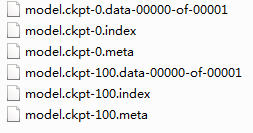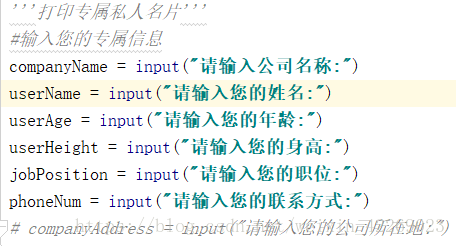详解tensorflow训练自己的数据集实现CNN图像分类
利用卷积神经网络训练图像数据分为以下几个步骤
1.读取图片文件
2.产生用于训练的批次
3.定义训练的模型(包括初始化参数,卷积、池化层等参数、网络)
4.训练
1 读取图片文件
def get_files(filename): class_train = [] label_train = [] for train_class in os.listdir(filename): for pic in os.listdir(filename+train_class): class_train.append(filename+train_class+'/'+pic) label_train.append(train_class) temp = np.array([class_train,label_train]) temp = temp.transpose() #shuffle the samples np.random.shuffle(temp) #after transpose, images is in dimension 0 and label in dimension 1 image_list = list(temp[:,0]) label_list = list(temp[:,1]) label_list = [int(i) for i in label_list] #print(label_list) return image_list,label_list
这里文件名作为标签,即类别(其数据类型要确定,后面要转为tensor类型数据)。
然后将image和label转为list格式数据,因为后边用到的的一些tensorflow函数接收的是list格式数据。
2 产生用于训练的批次
def get_batches(image,label,resize_w,resize_h,batch_size,capacity):
#convert the list of images and labels to tensor
image = tf.cast(image,tf.string)
label = tf.cast(label,tf.int64)
queue = tf.train.slice_input_producer([image,label])
label = queue[1]
image_c = tf.read_file(queue[0])
image = tf.image.decode_jpeg(image_c,channels = 3)
#resize
image = tf.image.resize_image_with_crop_or_pad(image,resize_w,resize_h)
#(x - mean) / adjusted_stddev
image = tf.image.per_image_standardization(image)
image_batch,label_batch = tf.train.batch([image,label],
batch_size = batch_size,
num_threads = 64,
capacity = capacity)
images_batch = tf.cast(image_batch,tf.float32)
labels_batch = tf.reshape(label_batch,[batch_size])
return images_batch,labels_batch
首先使用tf.cast转化为tensorflow数据格式,使用tf.train.slice_input_producer实现一个输入的队列。
label不需要处理,image存储的是路径,需要读取为图片,接下来的几步就是读取路径转为图片,用于训练。
CNN对图像大小是敏感的,第10行图片resize处理为大小一致,12行将其标准化,即减去所有图片的均值,方便训练。
接下来使用tf.train.batch函数产生训练的批次。
最后将产生的批次做数据类型的转换和shape的处理即可产生用于训练的批次。
3 定义训练的模型
(1)训练参数的定义及初始化
def init_weights(shape):
return tf.Variable(tf.random_normal(shape,stddev = 0.01))
#init weights
weights = {
"w1":init_weights([3,3,3,16]),
"w2":init_weights([3,3,16,128]),
"w3":init_weights([3,3,128,256]),
"w4":init_weights([4096,4096]),
"wo":init_weights([4096,2])
}
#init biases
biases = {
"b1":init_weights([16]),
"b2":init_weights([128]),
"b3":init_weights([256]),
"b4":init_weights([4096]),
"bo":init_weights([2])
}
CNN的每层是y=wx+b的决策模型,卷积层产生特征向量,根据这些特征向量带入x进行计算,因此,需要定义卷积层的初始化参数,包括权重和偏置。其中第8行的参数形状后边再解释。
(2)定义不同层的操作
def conv2d(x,w,b): x = tf.nn.conv2d(x,w,strides = [1,1,1,1],padding = "SAME") x = tf.nn.bias_add(x,b) return tf.nn.relu(x) def pooling(x): return tf.nn.max_pool(x,ksize = [1,2,2,1],strides = [1,2,2,1],padding = "SAME") def norm(x,lsize = 4): return tf.nn.lrn(x,depth_radius = lsize,bias = 1,alpha = 0.001/9.0,beta = 0.75)
这里只定义了三种层,即卷积层、池化层和正则化层
(3)定义训练模型
def mmodel(images): l1 = conv2d(images,weights["w1"],biases["b1"]) l2 = pooling(l1) l2 = norm(l2) l3 = conv2d(l2,weights["w2"],biases["b2"]) l4 = pooling(l3) l4 = norm(l4) l5 = conv2d(l4,weights["w3"],biases["b3"]) #same as the batch size l6 = pooling(l5) l6 = tf.reshape(l6,[-1,weights["w4"].get_shape().as_list()[0]]) l7 = tf.nn.relu(tf.matmul(l6,weights["w4"])+biases["b4"]) soft_max = tf.add(tf.matmul(l7,weights["wo"]),biases["bo"]) return soft_max
模型比较简单,使用三层卷积,第11行使用全连接,需要对特征向量进行reshape,其中l6的形状为[-1,w4的第1维的参数],因此,将其按照“w4”reshape的时候,要使得-1位置的大小为batch_size,这样,最终再乘以“wo”时,最终的输出大小为[batch_size,class_num]
(4)定义评估量
def loss(logits,label_batches): cross_entropy = tf.nn.sparse_softmax_cross_entropy_with_logits(logits=logits,labels=label_batches) cost = tf.reduce_mean(cross_entropy) return cost 首先定义损失函数,这是用于训练最小化损失的必需量 def get_accuracy(logits,labels): acc = tf.nn.in_top_k(logits,labels,1) acc = tf.cast(acc,tf.float32) acc = tf.reduce_mean(acc) return acc
评价分类准确率的量,训练时,需要loss值减小,准确率增加,这样的训练才是收敛的。
(5)定义训练方式
def training(loss,lr): train_op = tf.train.RMSPropOptimizer(lr,0.9).minimize(loss) return train_op
有很多种训练方式,可以自行去官网查看,但是不同的训练方式可能对应前面的参数定义不一样,需要另行处理,否则可能报错。
4 训练
def run_training():
data_dir = 'C:/Users/wk/Desktop/bky/dataSet/'
image,label = inputData.get_files(data_dir)
image_batches,label_batches = inputData.get_batches(image,label,32,32,16,20)
p = model.mmodel(image_batches)
cost = model.loss(p,label_batches)
train_op = model.training(cost,0.001)
acc = model.get_accuracy(p,label_batches)
sess = tf.Session()
init = tf.global_variables_initializer()
sess.run(init)
coord = tf.train.Coordinator()
threads = tf.train.start_queue_runners(sess = sess,coord = coord)
try:
for step in np.arange(1000):
print(step)
if coord.should_stop():
break
_,train_acc,train_loss = sess.run([train_op,acc,cost])
print("loss:{} accuracy:{}".format(train_loss,train_acc))
except tf.errors.OutOfRangeError:
print("Done!!!")
finally:
coord.request_stop()
coord.join(threads)
sess.close()
神经网络训练的时候,我们需要将模型保存下来,方便后面继续训练或者用训练好的模型进行测试。因此,我们需要创建一个saver保存模型。
def run_training():
data_dir = 'C:/Users/wk/Desktop/bky/dataSet/'
log_dir = 'C:/Users/wk/Desktop/bky/log/'
image,label = inputData.get_files(data_dir)
image_batches,label_batches = inputData.get_batches(image,label,32,32,16,20)
print(image_batches.shape)
p = model.mmodel(image_batches,16)
cost = model.loss(p,label_batches)
train_op = model.training(cost,0.001)
acc = model.get_accuracy(p,label_batches)
sess = tf.Session()
init = tf.global_variables_initializer()
sess.run(init)
saver = tf.train.Saver()
coord = tf.train.Coordinator()
threads = tf.train.start_queue_runners(sess = sess,coord = coord)
try:
for step in np.arange(1000):
print(step)
if coord.should_stop():
break
_,train_acc,train_loss = sess.run([train_op,acc,cost])
print("loss:{} accuracy:{}".format(train_loss,train_acc))
if step % 100 == 0:
check = os.path.join(log_dir,"model.ckpt")
saver.save(sess,check,global_step = step)
except tf.errors.OutOfRangeError:
print("Done!!!")
finally:
coord.request_stop()
coord.join(threads)
sess.close()
训练好的模型信息会记录在checkpoint文件中,大致如下:
model_checkpoint_path: "C:/Users/wk/Desktop/bky/log/model.ckpt-100"
all_model_checkpoint_paths: "C:/Users/wk/Desktop/bky/log/model.ckpt-0"
all_model_checkpoint_paths: "C:/Users/wk/Desktop/bky/log/model.ckpt-100"
其余还会生成一些文件,分别记录了模型参数等信息,后边测试的时候程序会读取checkpoint文件去加载这些真正的数据文件

构建好神经网络进行训练完成后,如果用之前的代码直接进行测试,会报shape不符合的错误,大致是卷积层的输入与图像的shape不一致,这是因为上篇的代码,将weights和biases定义在了模型的外面,调用模型的时候,出现valueError的错误。

因此,我们需要将参数定义在模型里面,加载训练好的模型参数时,训练好的参数才能够真正初始化模型。重写模型函数如下
def mmodel(images,batch_size):
with tf.variable_scope('conv1') as scope:
weights = tf.get_variable('weights',
shape = [3,3,3, 16],
dtype = tf.float32,
initializer=tf.truncated_normal_initializer(stddev=0.1,dtype=tf.float32))
biases = tf.get_variable('biases',
shape=[16],
dtype=tf.float32,
initializer=tf.constant_initializer(0.1))
conv = tf.nn.conv2d(images, weights, strides=[1,1,1,1], padding='SAME')
pre_activation = tf.nn.bias_add(conv, biases)
conv1 = tf.nn.relu(pre_activation, name= scope.name)
with tf.variable_scope('pooling1_lrn') as scope:
pool1 = tf.nn.max_pool(conv1, ksize=[1,2,2,1],strides=[1,2,2,1],
padding='SAME', name='pooling1')
norm1 = tf.nn.lrn(pool1, depth_radius=4, bias=1.0, alpha=0.001/9.0,
beta=0.75,name='norm1')
with tf.variable_scope('conv2') as scope:
weights = tf.get_variable('weights',
shape=[3,3,16,128],
dtype=tf.float32,
initializer=tf.truncated_normal_initializer(stddev=0.1,dtype=tf.float32))
biases = tf.get_variable('biases',
shape=[128],
dtype=tf.float32,
initializer=tf.constant_initializer(0.1))
conv = tf.nn.conv2d(norm1, weights, strides=[1,1,1,1],padding='SAME')
pre_activation = tf.nn.bias_add(conv, biases)
conv2 = tf.nn.relu(pre_activation, name='conv2')
with tf.variable_scope('pooling2_lrn') as scope:
norm2 = tf.nn.lrn(conv2, depth_radius=4, bias=1.0, alpha=0.001/9.0,
beta=0.75,name='norm2')
pool2 = tf.nn.max_pool(norm2, ksize=[1,2,2,1], strides=[1,1,1,1],
padding='SAME',name='pooling2')
with tf.variable_scope('local3') as scope:
reshape = tf.reshape(pool2, shape=[batch_size, -1])
dim = reshape.get_shape()[1].value
weights = tf.get_variable('weights',
shape=[dim,4096],
dtype=tf.float32,
initializer=tf.truncated_normal_initializer(stddev=0.005,dtype=tf.float32))
biases = tf.get_variable('biases',
shape=[4096],
dtype=tf.float32,
initializer=tf.constant_initializer(0.1))
local3 = tf.nn.relu(tf.matmul(reshape, weights) + biases, name=scope.name)
with tf.variable_scope('softmax_linear') as scope:
weights = tf.get_variable('softmax_linear',
shape=[4096, 2],
dtype=tf.float32,
initializer=tf.truncated_normal_initializer(stddev=0.005,dtype=tf.float32))
biases = tf.get_variable('biases',
shape=[2],
dtype=tf.float32,
initializer=tf.constant_initializer(0.1))
softmax_linear = tf.add(tf.matmul(local3, weights), biases, name='softmax_linear')
return softmax_linear
测试训练好的模型
首先获取一张测试图像
def get_one_image(img_dir): image = Image.open(img_dir) plt.imshow(image) image = image.resize([32, 32]) image_arr = np.array(image) return image_arr
加载模型,计算测试结果
def test(test_file):
log_dir = 'C:/Users/wk/Desktop/bky/log/'
image_arr = get_one_image(test_file)
with tf.Graph().as_default():
image = tf.cast(image_arr, tf.float32)
image = tf.image.per_image_standardization(image)
image = tf.reshape(image, [1,32, 32, 3])
print(image.shape)
p = model.mmodel(image,1)
logits = tf.nn.softmax(p)
x = tf.placeholder(tf.float32,shape = [32,32,3])
saver = tf.train.Saver()
with tf.Session() as sess:
ckpt = tf.train.get_checkpoint_state(log_dir)
if ckpt and ckpt.model_checkpoint_path:
global_step = ckpt.model_checkpoint_path.split('/')[-1].split('-')[-1]
saver.restore(sess, ckpt.model_checkpoint_path)
print('Loading success)
else:
print('No checkpoint')
prediction = sess.run(logits, feed_dict={x: image_arr})
max_index = np.argmax(prediction)
print(max_index)
前面主要是将测试图片标准化为网络的输入图像,15-19是加载模型文件,然后将图像输入到模型里即可
以上就是本文的全部内容,希望对大家的学习有所帮助,也希望大家多多支持【听图阁-专注于Python设计】。
